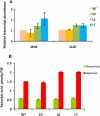Reduction of inositol (1,4,5)-trisphosphate affects the overall phosphoinositol pathway and leads to modifications in light signalling and secondary metabolism in tomato plants
- PMID: 21994174
- PMCID: PMC3254682
- DOI: 10.1093/jxb/err306
Reduction of inositol (1,4,5)-trisphosphate affects the overall phosphoinositol pathway and leads to modifications in light signalling and secondary metabolism in tomato plants
Abstract
The phosphoinositol pathway is one of the major eukaryotic signalling pathways. The metabolite of the phosphoinositol pathway, inositol- (1,4,5) trisphosphate (InsP(3)), is a regulator of plant responses to a wide variety of stresses, including light, drought, cold, and salinity. It was found that the expression of InsP 5-ptase, the enzyme that hydrolyses InsP(3), also dramatically affects the levels of inositol phosphate metabolites and the secondary metabolites in transgenic tomato plants. Tomato plants expressing InsP 5-ptase exhibited a reduction in the levels of several important inositol phosphates, including InsP(1), InsP(2), InsP(3), and InsP(4). Reduced levels of inositol phosphates accompanied an increase in the accumulation of phenylpropanoids (rutin, chlorogenic acid) and ascorbic acid (vitamin C) in the transgenic fruits of tomato plants. The enhanced accumulation of these metabolites in transgenic tomato plants was in direct correspondence with the observed up-regulation of the genes that express the key enzymes of ascorbic acid metabolism (myo-inositol oxygenase, MIOX; L-galactono-γ-lactone dehydrogenase, GLDH) and phenylpropanoid metabolism (chalcone synthase, CHS1; cinnamoyl-CoA shikimate/quinate transferase, HCT). To understand the molecular links between the activation of different branches of plant metabolism and InsP(3) reduction in tomato fruits, the expression of transcription factors known to be involved in light signalling was analysed by real-time RT-PCR. The expression of LeHY5, SIMYB12, and LeELIP was found to be higher in fruits expressing InsP 5-ptase. These results suggest possible interconnections between phosphoinositol metabolism, light signalling, and secondary metabolism in plants. Our study also revealed the biotechnological potential for the genetic improvement of crop plants by the manipulation of the phosphoinositol pathway.
Figures





References
-
- Agius F, González-Limothe R, Caballero JL, Muñoz-Blanco J, Botella MA, Valpuesta V. Engineering increased vitamin C levels in plants by over-expression of a D-galacturonic acid reductase. Nature Biotechnology. 2003;21:177–181. - PubMed
-
- Ang LH, Chattopadhyay S, Wei N, Oyama T, Okada K, Batschauer A, Deng XW. Molecular interaction between COP1 and HY5 defines a regulatory switch for light control of Arabidopsis development. Molecular Cell. 1998;1:213–222. - PubMed
-
- Bruno AK, Wetzel CM. The early light inducible protein (ELIP) gene is expressed during the chloroplast-to-chromoplast transition in ripening tomato fruit. Journal of Experimental Botany. 2004;55:2541–2548. - PubMed

